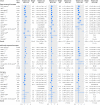Consumption of sugar sweetened beverages, artificially sweetened beverages, and fruit juice and incidence of type 2 diabetes: systematic review, meta-analysis, and estimation of population attributable fraction
- PMID: 26199070
- PMCID: PMC4510779
- DOI: 10.1136/bmj.h3576
Consumption of sugar sweetened beverages, artificially sweetened beverages, and fruit juice and incidence of type 2 diabetes: systematic review, meta-analysis, and estimation of population attributable fraction
Abstract
Objectives: To examine the prospective associations between consumption of sugar sweetened beverages, artificially sweetened beverages, and fruit juice with type 2 diabetes before and after adjustment for adiposity, and to estimate the population attributable fraction for type 2 diabetes from consumption of sugar sweetened beverages in the United States and United Kingdom.
Design: Systematic review and meta-analysis.
Data sources and eligibility: PubMed, Embase, Ovid, and Web of Knowledge for prospective studies of adults without diabetes, published until February 2014. The population attributable fraction was estimated in national surveys in the USA, 2009-10 (n = 4729 representing 189.1 million adults without diabetes) and the UK, 2008-12 (n = 1932 representing 44.7 million).
Synthesis methods: Random effects meta-analysis and survey analysis for population attributable fraction associated with consumption of sugar sweetened beverages.
Results: Prespecified information was extracted from 17 cohorts (38,253 cases/10,126,754 person years). Higher consumption of sugar sweetened beverages was associated with a greater incidence of type 2 diabetes, by 18% per one serving/day (95% confidence interval 9% to 28%, I(2) for heterogeneity = 89%) and 13% (6% to 21%, I(2) = 79%) before and after adjustment for adiposity; for artificially sweetened beverages, 25% (18% to 33%, I(2) = 70%) and 8% (2% to 15%, I(2) = 64%); and for fruit juice, 5% (-1% to 11%, I(2) = 58%) and 7% (1% to 14%, I(2) = 51%). Potential sources of heterogeneity or bias were not evident for sugar sweetened beverages. For artificially sweetened beverages, publication bias and residual confounding were indicated. For fruit juice the finding was non-significant in studies ascertaining type 2 diabetes objectively (P for heterogeneity = 0.008). Under specified assumptions for population attributable fraction, of 20.9 million events of type 2 diabetes predicted to occur over 10 years in the USA (absolute event rate 11.0%), 1.8 million would be attributable to consumption of sugar sweetened beverages (population attributable fraction 8.7%, 95% confidence interval 3.9% to 12.9%); and of 2.6 million events in the UK (absolute event rate 5.8%), 79,000 would be attributable to consumption of sugar sweetened beverages (population attributable fraction 3.6%, 1.7% to 5.6%).
Conclusions: Habitual consumption of sugar sweetened beverages was associated with a greater incidence of type 2 diabetes, independently of adiposity. Although artificially sweetened beverages and fruit juice also showed positive associations with incidence of type 2 diabetes, the findings were likely to involve bias. None the less, both artificially sweetened beverages and fruit juice were unlikely to be healthy alternatives to sugar sweetened beverages for the prevention of type 2 diabetes. Under assumption of causality, consumption of sugar sweetened beverages over years may be related to a substantial number of cases of new onset diabetes.
© Imamura et al 2015.
Conflict of interest statement
Competing interests: All authors have completed the ICMJE uniform disclosure form at
Figures



Comment in
-
Compelling evidence linking sugary drinks with diabetes.BMJ. 2015 Jul 29;351:h4087. doi: 10.1136/bmj.h4087. BMJ. 2015. PMID: 26224343 No abstract available.
-
Sugar sweetened beverages are associated with greater incidence of diabetes but there is a paucity of evidence on healthfulness of artificially-sweetened beverages and fruit juices.Evid Based Med. 2016 Feb;21(1):35. doi: 10.1136/ebmed-2015-110283. Epub 2015 Oct 27. Evid Based Med. 2016. PMID: 26507642 No abstract available.
References
-
- Stanhope KL. Role of fructose-containing sugars in the epidemics of obesity and metabolic syndrome. Annu Rev Med 2012;63:329-43. - PubMed
-
- Greenwood DC, Threapleton DE, Evans CEL, et al. Association between sugar-sweetened and artificially sweetened soft drinks and type 2 diabetes: systematic review and dose-response meta-analysis of prospective studies. Br J Nutr 2014;112:725-34. - PubMed
Publication types
MeSH terms
Substances
Grants and funding
LinkOut - more resources
Full Text Sources
Other Literature Sources
Medical
